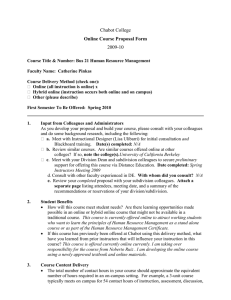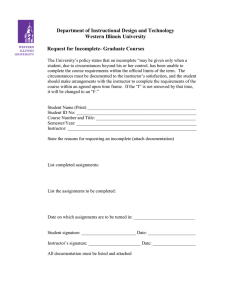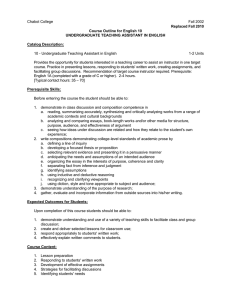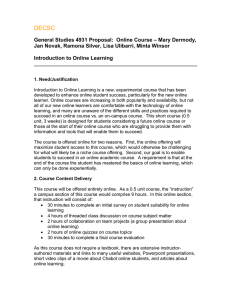Chabot College Spring 2013 Online Course Proposal Form
advertisement
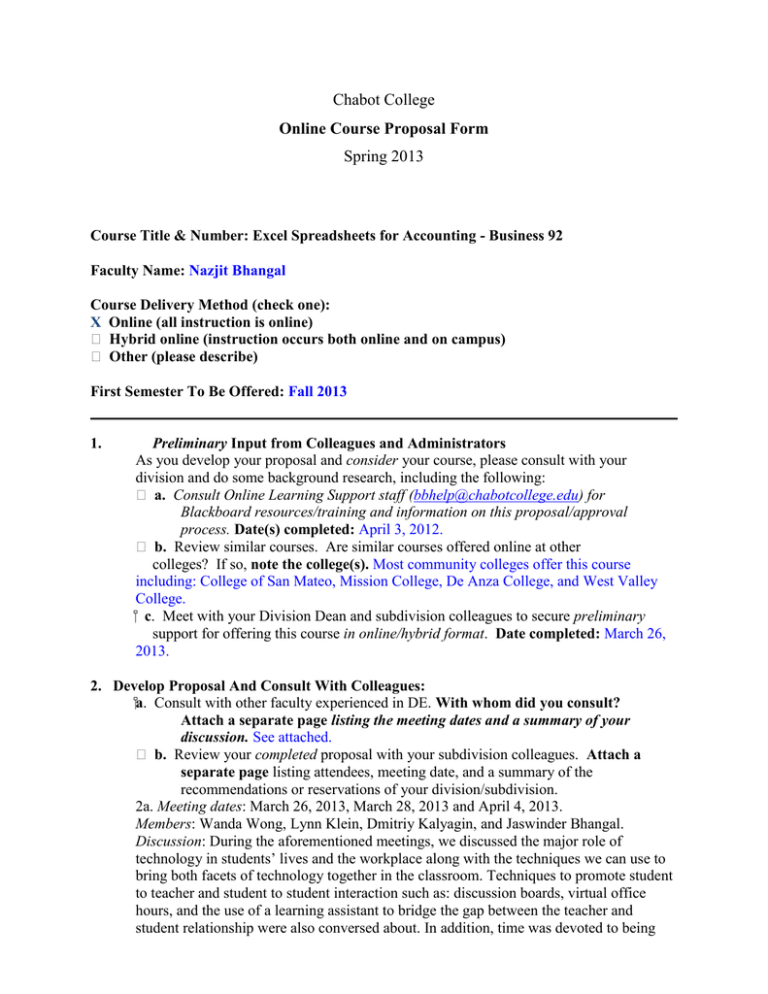
Chabot College Online Course Proposal Form Spring 2013 Course Title & Number: Excel Spreadsheets for Accounting - Business 92 Faculty Name: Nazjit Bhangal Course Delivery Method (check one): X Online (all instruction is online) Hybrid online (instruction occurs both online and on campus) Other (please describe) First Semester To Be Offered: Fall 2013 1. Preliminary Input from Colleagues and Administrators As you develop your proposal and consider your course, please consult with your division and do some background research, including the following: a. Consult Online Learning Support staff (bbhelp@chabotcollege.edu) for Blackboard resources/training and information on this proposal/approval process. Date(s) completed: April 3, 2012. b. Review similar courses. Are similar courses offered online at other colleges? If so, note the college(s). Most community colleges offer this course including: College of San Mateo, Mission College, De Anza College, and West Valley College. c. Meet with your Division Dean and subdivision colleagues to secure preliminary support for offering this course in online/hybrid format. Date completed: March 26, 2013. 2. Develop Proposal And Consult With Colleagues: a. Consult with other faculty experienced in DE. With whom did you consult? Attach a separate page listing the meeting dates and a summary of your discussion. See attached. b. Review your completed proposal with your subdivision colleagues. Attach a separate page listing attendees, meeting date, and a summary of the recommendations or reservations of your division/subdivision. 2a. Meeting dates: March 26, 2013, March 28, 2013 and April 4, 2013. Members: Wanda Wong, Lynn Klein, Dmitriy Kalyagin, and Jaswinder Bhangal. Discussion: During the aforementioned meetings, we discussed the major role of technology in students’ lives and the workplace along with the techniques we can use to bring both facets of technology together in the classroom. Techniques to promote student to teacher and student to student interaction such as: discussion boards, virtual office hours, and the use of a learning assistant to bridge the gap between the teacher and student relationship were also conversed about. In addition, time was devoted to being coached on the subject of Blackboard functionality in order to develop the capability to properly form and maintain the course. Consequently, the importance of having a suitable number of “contact hours” was communicated. 2b. Meeting dates: April 7, 2013. Members: Wanda Wong, Dmitriy Kalyagin, and Jaswinder Bhangal. Discussion: Other than grammatical changes, the attendees mentioned above recommended several strategies to promote student to student and student to instructor interaction. Some of these recommendations included having students reply to their fellow students’ threads, updating the “Grade Book” frequently, and reach out to students who are not participating biweekly. The attendees also encouraged the use of a learning assistant in order to make the students more comfortable about asking questions. Additionally, it was suggested that the instructor create a button on Blackboard solely for introductory items in order to communicate guidelines upfront and to limit the number of miscommunications throughout the course. 3. Student Benefits How will this course meet student needs? Are there learning opportunities made possible in an online or hybrid online course that might not be available in a traditional course? Business 92 is a required course for student striving to achieve an A.S. in Accounting, a Bookkeeping certificate, and an Accounting Technician certificate. Not only is Excel knowledge a requirement to acquire the aforementioned credentials, but also accounting departments rely heavily on the output generated by Excel to complete everyday tasks. In addition, entrepreneurs can learn how to manage their small to medium sized businesses with the skills Business 92 teaches. An online course of this nature can serve as a great tool for the employed who are looking for an opportunity to conveniently increase their Excel knowledge while maintaining a full time job. Additionally, students with limitations due to distance or disability can enroll in an online Business 92 course and expand their knowledge of the useful software without leaving their home. If this course has previously been offered at Chabot using this delivery method, what have you learned from prior instructors that will influence your instruction in this course? The course has been offered in the online modality at Chabot for a number of years. Prior instructors of this course have experienced that if an individual lays out clear guidelines ahead of time, there is less room for miscommunication between the student and instructor in the long run. Consequently, the instructor in this Business 92 course will include an introductory section which communicates the guidelines for submitting assignments, posting on the discussion boards, grading on locked exams and quizzes, and the functionality of Blackboard. In addition, the use of a learning assistant seems to give the students a sense of comfort in terms of asking questions. The instructor will be exploring the possibility of having a learning assistant and creating a discussion board forum where students can ask him/her questions about the material in addition to a forum where students can ask me questions. 4. Course Content Delivery The total number of contact hours in your course should approximate the equivalent number of hours required in an on-campus setting. For example, a 3-unit course typically meets on campus for 54 contact hours of instruction, assessment, discussion, and group activities. In the Carnegie unit system, students are also expected to invest two hours “outside of class” for every hour in class on reading, studying, preparing assignments, and other homework; these additional hours are not considered to be “contact hours”. Account for the contact hours in your proposal in a clear, detailed and specific way. (PLEASE NOTE: For a more detailed explanation of “contact hours”, be sure to see the Addendum attached to this form.) Business 92 live is approximately 54 hours on campus; as a result, the online course will consist of the same number of hours divided into the following: Power Point presentations – 10 hours Chapter outlines – 5 hours Electronic lectures – 8 hours Examples/Demonstrations – 5 hours Discussion board participation – 8 hours Multimedia Content – 4 hours Quizzes – 8 hours Exams – 6 hours What percentage of the course will be on-campus, if any? What percentage of the course will consist of online lecture (text, presentations, podcasts, video), class discussions (discussion board forums), group projects (blogs, journals), online resources (Publisher content/websites, course cartridges/packages), assignments, student research, reading, writing, & assessments? Please be sure to list each of your contact hour/instructional activities and indicate how these will be delivered throughout the course and the amount of hours or percentage that they will entail. This course will be solely an online course. The course will be organized by chapters on Blackboard and each chapter will have an individual lesson plan in order to provide a centralized and convenient learning platform. Power point presentations, chapter outlines, electronic lectures, and demonstrations will consume about 52% of the contact hours. The demonstrations will consist of practical hand-on scenarios in order to actively engage students into the material. Discussion boards will utilize approximately 15% of the total contact hours as students will be required to make posts in response to practical questions and respond to their classmates’ threads. With the emphasis on getting everything done quickly and efficiently in recent times, multimedia illustrating the uses of efficient hotkeys will be inserted into each lesson plan and consume about 8% of the contact hours. The remaining 26% of contact hours will be designated for quizzes and exams. Each quiz will allow three attempts and the highest score will be chosen for the final grade in order to avoid any conflicts regarding locked exams. Will any portion of your course be synchronous, requiring students to be online at the same time? If so, describe those activities, and how you will provide flexibility for students who may be unable to participate at any given time. The course will not consist of any synchronous activity; however, a portion of the students’ grades will be based upon a group project requiring them to translate an extensive, but poorly formatted, Balance Sheet and Income Statement into a summarized Trial Balance. This translation will require the students to use several formatting techniques meanwhile the summarization of the trial balance will contribute to the use of formulas. Since the project will be over the course of a week through two weeks, students will have the flexibility of working at their convenience. 5. Nature and Frequency of Instructor-Student Interactions How and how frequently will you interact with your students? This should include interactions with the entire class, providing feedback on assignments, and interventions when students are at-risk of dropping or failing due to poor performance or participation. In order to promote an open environment, the instructor will explore listing his/her cell phone number on the syllabus along with clear guidelines for contact hours. The guidelines (listed in an introductory section in Blackboard) will specify two hours a day for two days a week where the students could contact the instructor with any questions. Another contributor to the open door policy will be a discussion board forum devoted to asking the instructor any questions. This in addition, to ease the students into feeling more comfortable with “Instructor-Student Interactions” the instructor will explore the opportunity of working with a learning assistant in order to bridge the gap between the students and teacher. The instructor will continuously monitor the students’ online participation through “Grade Book” which displays the students’ last login. Consequently, students lacking participation will be emailed biweekly. Several announcements will be relayed to the class consisting of: homework reminders, links to helpful Excel shortcut videos, and exam/quiz reminders. In addition to the aforementioned items, the following steps taken by the instructor will also encourage an interactive experience: prompt replies to emails, regular monitoring of students’ participation in the discussion board, communication via phone or face to face if necessary and continuous updating of grades throughout the semester in order to provide frequent feedback. For each type of interaction, describe why you believe it will be effective for this particular course. Weekly discussion boards allow students to address any questions or concerns they may have with the course material of the week. Multiple students may have the same question so this discussion board is a very valuable tool for students to reference when a question arises. Email and communication via phone will allow the instructor to encourage those students who lack participation and need extra motivation. 6. Nature and Frequency of Student-Student Interactions Describe opportunities in your course for student to student interaction. This may include discussions, group projects, peer review of assignments, and other approaches. Consider how students interact in this course when taught on campus; how can you build this type of learning community online? The first step in promoting student to student interaction would be an icebreaker requiring all students to introduce themselves through the discussion board as this would instill a sense of togetherness amongst the students. In addition to a student creating his/her own thread on a discussion board topic, the student will have to submit relevant replies to two fellow students’ threads. In order to promote an environment where students attempt to work together, a discussion board forum will be designated for students to post helpful Excel hints to each other. 7. Assessment of Student Learning How will you assess learning in this course? Given the nature of online courses, how does your assessment plan ensure a level of academic integrity with which you’re comfortable? Students will have to complete the following in order to illustrate their understanding of the material: weekly quizzes, an assignment per chapter, meaningful and relevant discussions through the discussion board, a group project, a midterm and a comprehensive final. In order to ensure the academic integrity of the course, all of the previously listed items will be carefully reviewed and assessed. Describe how your assessment plan is consistent with your stated goals in the student benefits and student-student interactions sections of your proposal. How will you provide feedback to students? The group project and discussion board assignments serve as a channel to make the students collaborate as well as understand the material. Meanwhile, the weekly assignments and quizzes will prepare the students for the comprehensive final exam. However, the core objective of the course is to prepare the students for workplace scenarios through practical examples on all methods of assessment (assignments, discussion boards, the group project, quizzes, and exams). Students will be given feedback consistently through the “Grade Book” feature. The “Grade Book” will be one of the many vehicles for the instructor to communicate the status of the students’ understanding of the material. Email, face to face meetings, and communication via the phone is another medium the instructor will use to convey constructive feedback. 8. Technology Describe any software or multimedia tools you plan to utilize in your course: PowerPoint (with or without audio),Publisher content/websites, Course Cartridges/Packages, Camtasia, Jing, Dragon Naturally Speaking, Flash, Audio (including Audacity and podcasts),YouTube/EduStream/Web-based videos, etc.). This is helpful to determine technology support needs. Please be specific in listing the technological tools you intend to use for your online or hybrid course. Students are required to have access to a reliable internet connection, a Blackboard account, and Microsoft Excel to be able to satisfy course objectives. Youtube videos (requiring flash) will be posted on Blackboard in order to provide helpful hints to increase efficiency with hot keys. 9. Accommodations for Students with Disabilities Is any required video close-captioned? Is there any required audio accompanied by a transcript? If you plan to use any multimedia (video, audio, publisher sites specialized software), is that accessible to your students in terms of both software availability at home and on campus and accessible for students with disabilities? Have you provided alt-tags for your key images used in your course? Please contact the Chabot DSRC (Disabled Students Resource Centerhttp://www.chabotcollege.edu/DSRC/) if you need help in ensuring accessibility for your students. The instructor will attempt to include only closed-captioned videos using flash which is easily available to all students at home or on campus. In addition, the accessibility features in Blackboard that can accommodate students with disabilities. The DSRC services will be listed in the introductory course section in order to make all students aware of the resource. 10. Submit your proposal (electronic version via email and hard copy via campus mail) to the chair of the Committee on Online Learning. Faculty signature: _______________________________ Date: _______________ Division Dean signature: __________________________ Date: ________________ Online/Hybrid Proposal Form Addendum: Committee On Online Learning/Chabot College What are Actual Contact Hours? The total number of contact hours in your course should approximate the equivalent number of hours required in an on-campus setting. For example, a 3-unit course typically meets on campus for 54 contact hours of instruction, assessment, discussion, and group activities, (Note: Instructional Hours are 50 minutes long). In the Carnegie unit system, students are also expected to invest two hours “outside of class” for every hour in class on reading, studying, preparing assignments, and other homework; these additional hours are not considered to be “contact hours”. Thus, you will need to account for the actual contact hours in your proposal. In accounting for contact hours an instructor needs to consider how each hour will be dispersed throughout each week of his/her online or hybrid course. In addition, students should be expected to spend two preparatory hours “outside of class” per every contact hour. The following chart illustrates some sample activities for an online class. These are suggestions and each instructor would use whichever activities, best suited to the type of course and discipline being offered: Contact Hour or “In-class” Activities Read lectures/ content Participate in Discussion Board Forums Assessments – quizzes, tests, surveys Presentations From the Instructor View multimedia content Group Problem Solving Transformative Learning Activities in class: Responding to other learners in regard to certain questions that challenge a learner’s perspective on key issues in the course materials. Reading another Student’s Blog Posting feedback, Reading student posts, and Peer Reviewing other Student’s papers on the discussion board or group forum. Group Projects that include multiple posts to each group member within their designated group forum space. “In class” reading of short texts, scenarios or quick discussion questions. Reading another student’s presentation. (This would be the equivalent of listening and viewing a student presentation in a face-to-face class.) Constructivist Assignments that target real-life applications for class discussion on the Discussion Board. Therefore, in preparing the online or hybrid proposal an instructor will need to explain how each instructional hour will be implemented throughout each week of his/her online or hybrid course. This can be done using percentages or actual hourly increments. For example an instructor may determine that 25 percent of his/her course will offer lectures and presentations, (13.5 contact hours), while another 25 percent of the contact hours will be used in constructivist assignments or asynchronistic discussion and peer responses, (13.5 contact hours). These are the same kinds of methods of instructional contact that are often used in a face-to-face class. However, there are certain learning activities that may not meet the criteria of actual “contact hours”. This chart reflects instructional, preparatory “outside of class” activities that in some cases would not necessarily be considered actual contact hours. Preparatory or “Outside of Class” Activities Read Textbooks Research Preparing assignments Viewing an internet site for one’s own research purposes. Individual Reflective Writing Journaling Writing /Composing a Blog Analyzing another student’s ideas individually. Using a WIKI for posting ideas to other class members in preparation for a Group Project. Outside reading of additional texts pertaining to the course subject matter as homework preparation. Preparing an individual class presentation. Reviewing class notes. In summary, “contact hours” are usually those segments of instructional time where the student is actively engaged in learning activities and would reflect the same type of instruction implemented in a traditional face-to-face classroom. Therefore, instructors are encouraged to offer a clear breakdown of “contact hours” in the section of the proposal entitled, “Course Content Delivery”.
